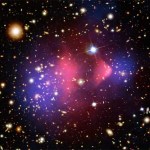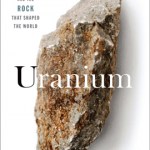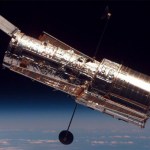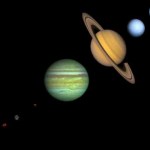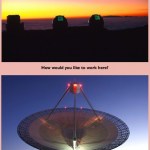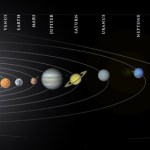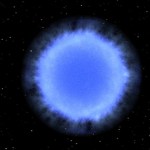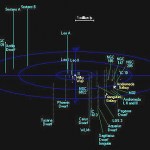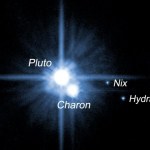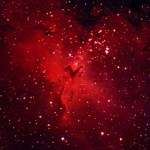
Last night, I had the pleasure of going to the Portland-area showing of the International Documentary Challenge. From March 5th-9th, 142 documentary filmmaking teams from 16 countries made short documentary films on the topics of Hope & Fear. I found out about it because I got solicited to be a co-star in one of them -- focused on fear -- on the topic of Dark Matter.
Dark matter makes for both fascinating pictures and for a fascinating subject. Well, there was a huge reason why I was a major player in this: this is an obscure topic that most people know very little about. In fact, nearly…
Let me give you a little back story. As many of you know, I'm new to scienceblogs, and one of the first things we get to do is join a message board full of all the bloggers (sciblings) here. Well, suffice it to say, a contentious discussion took place between me and another scibling, which resulted in my being called a total n00b in front of the entire world.
So, what better way to make peace than by having me -- an astrophysicist -- answer a question about physiology?! Let's take a look at what I've got, since I'm a frequent solicitor of questions:
Why is my pee yellow in the morning, but…
I want to thank everyone for their great interest in my last post on dark matter! I got an awful lot of questions about what I mean by dark matter being "collisionless," and in particular, about this picture:
This is two galaxy clusters that have collided recently. The pink shows the X-ray emissions, which comes from the normal matter in the clusters colliding and heating up. The blue shows the mass, and where it is, which I contend needs to be mostly dark matter.
Well, many of you are skeptical, and rightfully so. So I've decided to set you straight, by showing you a visual simulation (that…
Over the last few decades, we've learned a lot of interesting things about the Universe. One of the most groundbreaking is that most of the matter in the Universe is not made up of all the stuff we know as normal matter: protons, neutrons, and electrons.
This means that atoms, the basic building block of all we know and love on Earth, make up only a small fraction of the mass in the Universe.
How do we know this? Well, there are lots of reasons, but they all boil down to these two things: we use telescopes to measure light, which tells us about the amount of normal matter in the Universe,…
As a new tradition since we're on a new site, in addition to giving you a post about fun stuff on the weekend, I'm going to try exposing you to some new music, either by an uncommon artist or a song that really caught my fancy. This week's artist is Chicago-based bluegrass musician Colby Maddox, singing the old classic Shady Grove. Feel free to listen while you read on:
So I was looking around the internet the other day, and I came across this scientific study, which -- I kid you not -- is on the effects of tinfoil hats.
Now, the whole idea is that you can shield yourself from…
Last night, I was watching the Daily Show, and they had Tom Zoellner on, talking about his new book: Uranium: War, Energy, and the Rock that shaped the world.
There are certainly a lot of interesting things about Uranium in culture, particularly in terms of energy (hey, we can use this thing to power the world) and in terms of war (the nuclear arms race). If you look at what we've done with all the enriched Uranium (U-235, the fissionable type), the US and the Soviets, from the 1940s to the 1980s, basically took nearly all of it and stockpiled it.
This is the only element on Earth we've ever…
Most of you know that different fonts and typefaces can give your documents a certain feel, a certain flair, or a certain artistic element that you wouldn't get using the same old font for everything. So, I was reading an article about a relatively famous typographer, Eric Gill, the developer of a number of typefaces.
The interview is interesting, the history of typefaces is interesting, and getting a perspective on the world 100 years ago is also interesting. But the very last thing that he said, about artistry, beauty, and making something that's valuable, is really what stuck with me:
I…
One of the great things about the Hubble Space Telescope is that it's been in orbit for nearly 20 years now, meaning that it's amassed a huge archive of data.
Now, one of the things that the Hubble Space Telescope is notoriously bad at is finding planets. Why? Because if you want to do it, you have to block the light from a star, otherwise you'll never see anything other than the star.
So what you can do is place something called a coronagraph over the star, which is just a little black plate that blocks the star's light, and lets you see around it. This was first used for the Sun to view…
Welcome to our new home on the web! For those of you who are longtime readers of Starts With A Bang!, I welcome you to our new location! And to those of you who see me as a new face, it's my pleasure to meet you!
I'm looking forward to a long and healthy partnership with scienceblogs and their outstanding team of bloggers, including (some of my favorites):
Pharyngula -- full of irate opinions and outstanding biology,
Dynamics of Cats -- where theoretical physics and random events meet,
Framing Science -- Matthew Nisbet brings some reason to science communication, and
Eruptions -- Volcanoes,…
Brought to you by Max Cannon, creator of Red Meat and also the dude who helps run the awesome independent Loft Cinema here in Tucson:
Hilarious...
Also, if you haven't caught it yet, don't forget to check out this week's Carnival of Space, where we have an entry about actually seeing a supernova go off.
We need one of those propaganda videos, like the Marines had when I was a kid:
Seriously, I remember watching that and actually thinking it would be awesome to be a Marine! (And for those of you who don't know me that well, I loathe armed conflict.)
Well, I'm a scientist. Can't we do anything cool to attract people to be interested in it, or help support it? Baby steps, folks, baby steps. And Duncan Forbes at Swinburne in Australia (where I almost moved when I was offered a position with them last February) has composed a how-to guide entitled:
So You Want To Be A Professional Astronomer!
It…
The laws of physics are the same forwards in time as they are backwards, right?
At least, that's what some physicists will tell you. They have (some) good reasons for saying this. After all, if you watch the planets orbit the Sun, they look like they obey the same laws of physics whether you watch them orbit clockwise (forwards in time) or counterclockwise (backwards in time):
But is everything time symmetrical? Well, no, of course not. There are certain things that are easy to do moving forwards in time, like to take a raw egg or two (left) and fry them (right). Well, that's pretty easy.…
We know, more or less how supernovae work. We've seen them just hours after they first go off through telescopes and satellites. The Crab Nebula, also known as M1, was a supernova that went off nearly 1,000 years ago in our own galaxy, for example, and we can simulate pretty well that it formed like this:
But this is totally new: a paper is coming out in the journal Nature tomorrow (the 22nd of May), where they've caught a star exploding red-handed!
First things first; here's a quicktime movie of the explosion. Let's put up some screenshots of the Blue Giant star before the explosion:
Here'…
Some of you who've been following astronomy for awhile might remember this report, where a group of astronomers reported finding a giant "void" in the Universe.
What is a void? Well, galaxies are distributed pretty randomly, but because of gravity, they cluster together. A small example is our local group which looks like this,
and a larger example is the Virgo cluster, which is about 1,000 times as massive as our local group, and looks like this:
Well, a void is the opposite of a cluster, where you have a large volume of space that's simply empty of galaxies and matter. This press release…
No, really, I can hang with the big boys!
Although this is usually something we hear from people who are seemingly out of their league, due to diminutive stature, here on Earth:
(Muggsy Bogues is awesome.) Apparently, there are stars out there that have the same Napoleon Complex. According to this Press Release, a star only 1% as bright as the Sun just released a burst of energy as powerful as 1000 solar flares!
Now, that link is only too happy to provide you with an artist's rendition of what happened:
But let's compare this with real stuff, instead. Our Sun has a magnetic field that's…
Sometimes, you find weird stuff on the internet. But sometimes you find even weirder stuff in scientific journals. To what do I refer? A paper in the Journal of Mathematical Geology back in 2000 entitled Godzilla from a Zoological Perspective, by Per Christiansen.
This was written as a critique of the "new Godzilla" movie, arguing that it is not more biologically plausible than the "old Godzilla" of 1954.
However, calculations show that his limbs and limb muscles must have been severely undersized to move his huge bulk around at even a leisurely pace, and most other biological problems with…
This has been all over my inbox since the press release came out yesterday; it's been on slashdot (thanks Brian), it's been at space.com, and there's a mediocre writeup on Universe Today. What's the big news? Black Holes don't destroy information after all!
What is this whole information thing, anyway? Take a look at all the normal stuff in the Universe: photons, protons, neutrons, and electrons, for example. They have lots of different properties each. They move around one another, they get bound and unbound from one another, they exert forces on one another, etc. They're aware of one…
Sure, astronomers might not call it a planet anymore, but every schoolchild knows how badass Pluto really is. It's got a giant moon, Charon, and two smaller ones, Hydra and Nix.
In addition to being colder than ice with an average temperature of 44 Kelvin (that's colder than liquid nitrogen), I'm here to bring you the news that despite the fact that it's so cold and so far from the Sun, Pluto has been melting!
Since its discovery by Clyde Tombaugh in 1930, astronomers have been fascinated with Pluto, making very careful observations of it, trying to learn more about this bizarre, icy sphere…
Good news for science from... the Vatican? No joke. Father Gabriel Funes, director of the Vatican Observatory and chief astronomer for the Pope, has just issued a public statement stating the following things:
Intelligent beings could exist in outer space.
Life on Mars cannot be ruled out.
The search for extraterrestrial life does not contradict belief in God.
Next year, the Vatican is organizing a conference to mark the 200th anniversary of the birth of Charles Darwin.
Whoa. And whoa's wobbly cousin, woah. Did I just step into the 21st century? After my post last week on what Americans…
When I think of molecules, I think of Conan O'Brien doing his skit where he plays Moleculo...
the molecular man! I don't think of astronomy, and I certainly don't think of the leftover radiation from the big bang (known as the cosmic microwave background)! But somebody over at the European Southern Observatory put these two together and made an incredibly tasty science sandwich.
See, we can measure the cosmic microwave background today, because we have photons (particles of light) coming at us in all directions at all locations, with a temperature of 2.725 Kelvin. Theoretical cosmology…


